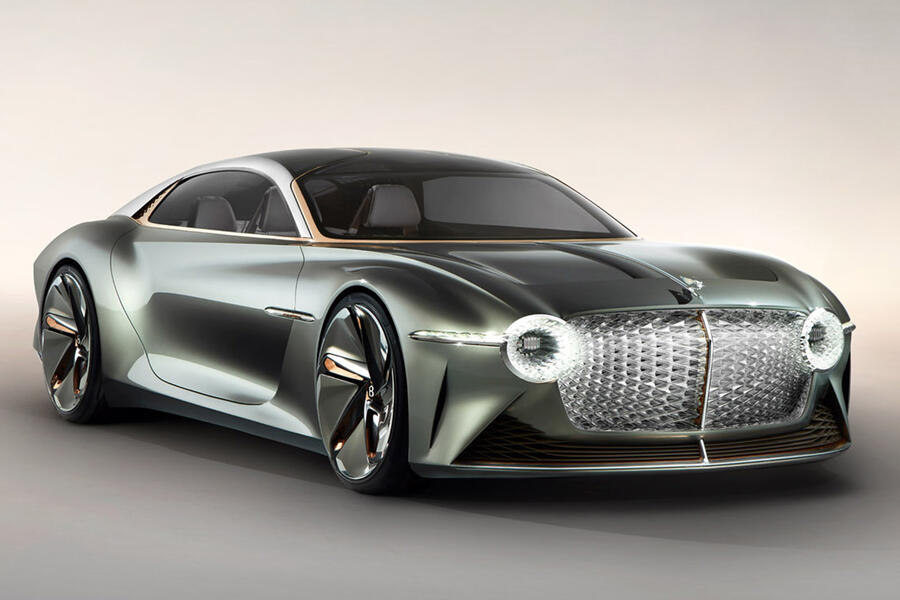Bentley has begun conceptual work on a new high-riding saloon that it’s preparing to launch as its first fully electric car. The radical model will further the firm’s ambition to establish itself as the most environmentally and sustainably led premium luxury car maker in the world.
In their bid to establish global leadership in these areas, Bentley bosses want to follow this year’s launch of the brand’s first hybrid models by revealing its first electric car by 2025. That date is already challenging designers and engineers as they wrestle with delivering a vehicle with sufficient range for customers looking for a grand touring experience along with the performance capability of today’s cars.
Heavy investment in battery technology is already helping to reduce the cost and improve the capability of batteries. However, it’s believed that the next notable step forward will come when solid-state batteries reach production, something that is not expected to happen until closer to the end of the decade. As such, Bentley is likely to launch its first electric car using a more mature version of today’s lithium ion battery technology.
However, Bentley CEO Adrian Hallmark has hinted to Autocar that his teams have already hit on one potential solution by designing a car with similarities to, but more extreme than, the Jaguar I-Pace. This machine combines a traditional saloon shape with a higher-riding bodystyle to accommodate the battery pack without pushing up into a full-SUV format, which is aerodynamically inefficient and therefore reduces range.
The upcoming Jaguar XJ and a related J-Pace model, plus a Land Rover – dubbed the Road Rover but not expected to carry that name into production – are set to follow a similar path, although Bentley’s interpretation is being envisioned to set new performance benchmarks for the industry.
“If we’re to launch an electric car in the mid-2020s, then it either needs to be smaller than today’s cars or the same size but not as upright, and smaller isn’t an appealing solution, as it implies a lower price segment,” said Hallmark. “The prediction is battery technology will have moved forward again by that date and that will put us at the edge of what we think we need to give customers: 300-350 miles of range, or enough to cruise at a 65mph average for five hours.
“We need to be looking at how we can deliver slippier cars with a profile that gets the most out of it aerodynamically in order to deliver on that promise.”
The target date of 2025 and Hallmark’s comments confirm growing evidence that the first Bentley EV will crown a position of environmental and sustainability leadership that the company has been building towards in recent years.












Join the debate
Add your comment
This has been very enlightening,...
...for it made no since to me, with Bentley doing so well financially, that they wouldn't invest in replacing their currect flagship vehicle. By making the Continental GT/Flying Spur the brands "New" flagship and the Bentayga their entry level vehicle, they can reallocate those funds for this BEV.
I wonder how much a Bentley,
I wonder how much a Bentley, not known for being lightweight, with a battery big enough to cart all that about for 300 miles will weigh in?
The chauffeur will need an HGV licence!
But such developments have to happen. In some ways an EV will be liberating for Bentley with easy access to plenty of bhp, refinement, no emission consequences and a packaging layout that is ideal for placing as much of an oppulent castle on top as you desire. Oh and a customer base that can afford that price tag with a whopping battery. Although the players car park will have to have some hefty chargers installed hooked up to the stadium.
The Apprentice wrote:
The chauffeur will be fine. If your driver passed the test before 1st January 1997, he/she will usually be allowed to drive vehicles up to 8250Kg maximum authorised weight (MAM). If passed after that date he/she can still drive vehicles up to 3500Kg MAM, although that might be pushing it...
Very confident
Well, Bentley seem very optimistic about there forth coming cars and the tech going inside it, going to be interesting to see the rivals ideas of cars in the future.